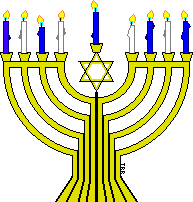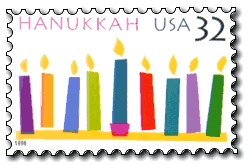 Hanukkah - Festival of Lights |
||
|
The Hebrew word Hanukkah means
"dedication." When the sacred
|
||
Another tradition of the holiday is playing dreidel, a gambling game played with a square top. Most people play for matchsticks, pennies, M&Ms or chocolate coins. A dreidel is marked with four Hebrew letters: Nun, Gimmel, Heh and Shin. |
 |
|
This supposedly stands for the Hebrew phrase "nes gadol hayah sham", a great miracle happened there. Actually, it stands for the Yiddish words nit (nothing), gantz (all), halb (half) and shtell (put), which are the rules of the game! There are variations in the way the game is played, but the way it was taught to me, everyone puts in a coin. Someone spins the dreidel. On Nun, nothing happens; on Gimmel (or, as kids call it, "gimme!"), you get the whole pot; on Heh, you get half of the pot; and on Shin, you put in one. When the pot is empty, everybody puts in one. Keep playing until one person has everything. Then redivide it and start over, because nobody likes a poor winner. |
||
|
||
Symbolic Hanukkah Foods
|
||
|
||
| The only religious
observance related to this holiday is the lighting of candles. The candles are arranged in a candelabrum called a menorah (or sometimes a chanukkiah) that holds nine candles: one for each night, plus a shammus (servant) at a different height. On the first night, one candle is placed at the far right. The shammus candle is lit and three berakhot (blessings) are recited: l'hadlik neir (a general prayer over candles), she-asah nisim (a prayer thanking God for performing miracles for our ancestors at this time), and she-hekhianu (a general prayer thanking God for allowing us to reach this time of year). After reciting the blessings, the first candle is then lit using the shammus candle, and the shammus candle is placed in its holder. The candles are allowed to burn out on their own after a minimum of one half hour. Each night, another candle is added from right to left (like the Hebrew language). Candles are lit from left to right (because you pay honor to the newer thing first). On the eighth night, all nine candles (the eight Hanukkah candles and the shammus) are lit. Why the shammus candle? The Hanukkah candles are for pleasure only; we are not allowed to use them for any productive purpose. We keep an extra one around (the shammus), so that if we need to do something useful with a candle, we don't accidentally use the Hanukkah candles. The shammus candle is at a different height so that it is easily identified as the shammus. |
 |
|
|
||
|
Hanukkah Links: Graphics on this page supplied by:
|
|
|
|
||
Home || Spring || Summer || Autumn || Winter January || February || March || April || [May || June || July
|
||
Updated: Tuesday, June 27, 2006 page design ©2000-06 GrannyDancer all rights reserved |
||
 |
||

